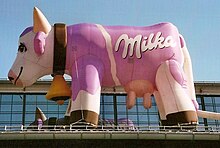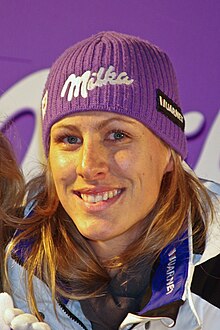Milka (brand)
Milka is a German - Swiss brand for chocolate products from the US food company Mondelēz International . The chocolate is produced in Lörrach in Baden-Württemberg and Swoge in Bulgaria .
Founding years
On November 17, 1825, the confectioner Philippe Suchard founded a confectionery in Neuchâtel (Switzerland). He promoted a new kind of handmade dessert , the " [le] chocolat fin de sa fabrique " ( French for "fine homemade chocolate"), the recipe of which has not been passed down. In 1826 he bought a former watermill in the neighboring village of Serrières and built a machine for chocolate bars there (approx. 25-30 kg per day).
Chocolate (except for drinking chocolate ) was originally made without milk , so it had a tart taste and dark brown color.
The Milka brand
In 1901 the brand name "Milka" was registered; the acronym was created from the contraction of the words " milk " and " cocoa ". Since then, Milka chocolate has been produced in Lörrach and offered in a purple envelope with a cow , the Milka cow , with a panorama of the Alps. In 1973 the Milka cow also got a purple color.
After Kraft Foods took over “Jacobs Suchard” in 1990, the name Suchard was gradually abandoned in packaging design and the recipes were changed.
The color purple plays a central role for the Milka brand. According to the Kraft company, Milka-Lila was the first abstract color trademark in 1995 to be protected across Europe in the broadest sense. In a hearing against the Verden biscuit and waffle factory Hans Freitag , which used a purple base tone for the packaging of a 500 gram biscuit mix, the Federal Court of Justice ruled on October 7, 2004 in a landmark judgment that the color purple should continue to be used in the packaging of chocolate products may only be used for Milka products.
Milka chocolate bars are still largely produced in the Lörrach plant (Germany) today. Around 140,000 tonnes of the various Milka chocolate bars are produced there every year - mainly 100 g bars. Further plants for other Milka products are located in Bludenz (Austria) with the production of approx. 60,000 tons (mainly large bars with 200 to 400 grams), in Strasbourg (France) as a center for pralines and in Bratislava (Slovakia) and Poznan (Poland). Bars (Leo) are produced in Herentals, Belgium.
In the Lörrach production site, a street adjacent to the plant has been renamed "Milkastraße".
In the 1990s, Peter Steiner became known through the Milka TV commercial , whose song "It's cool man" made it into the German, Austrian and Swiss charts. The bearded Steiner, who is already over 70 years old, embodied an Alm-Öhi who warned a city dweller about the prejudice that the people on the mountain were “old-fashioned”: “But be careful: It's cool man”.
The jingle Milka, the most tender temptation since the existence of chocolate, was composed by TV and film composer Christian Bruhn .
sorts
There are different flavors in the range, e.g. B. Alpine milk, hazelnut, strawberry, yoghurt, cream, caramel, nougat and white chocolate. It is regularly supplemented by special productions, including exotic flavors (e.g. "baked apple" in winter, see below).
Milka brand extensions include: Milka M-joy (in four varieties), Nussini, Tender, Milka Luflée, I love Milka, Milka Schoko & Keks Minis, Milka Leo, Milka Amavel, Milketten and Milka Snax (in four varieties). The limited Milka Choqsplash product expansion in hazelnut and mint varieties is new on the market.
In the meantime, the following have been hired again: Milka Lila Stars (chocolate raisins), Milka Fresh (“It's cool, man!”), Milka Schoko Drink, Milka Mona Lila and Milka Montelino.
In spring 2020 Milka launched a hazelnut cream spread.
Special productions
Under the Milka brand, special chocolate products are produced every year for Easter and Christmas, for Easter large chocolate bunnies and small chocolate eggs (also for spooning, e.g. Milka spoon egg 136g), for Christmas large, small, fat and thin Santa Clauses, sometimes filled, sometimes just made of chocolate and a cavity.
Filling amount of the bars
Milka is one of the few types of chocolate outside of the high-price segment that also produces bar sizes smaller than 100 grams: In recent years, the manufacturer Mondelez has brought various special types on the market that have the same optical dimensions, but their content is only 93 grams, 90 grams, 87 grams and finally 81 grams. The originally large 300-gram bar also has almost the same optical dimensions as before, but depending on the product, it sometimes only weighs 270 grams and may therefore be more expensive than three 100-gram bars.
cooperation
- In view of the competition on the globalized confectionery market, it was decided to cooperate in the form of co-branding . In Germany, for example, Milka is being promoted in the new Langnese ice cream spots. In return, five million Milka bars refer to the Langnese product “Cremissimo”.
- Philadelphia with Milka: Milka in cooperation with Philadelphia (also from Mondelēz) has a cream cheese-based spread with milk chocolate from the Alps.
- Chocolate bars of the varieties “Milka & Oreo ” and “Milka & Daim ” (also Mondelēz brands), and since October 2012 also “Milka & TUC Crackers” (Mondelēz brands) and “Milka & LU Biscuits” (also Mondelēz brand) .
- There is also a cooperation with Jacobs Tassimo , who offer a hot cocoa drink as a capsule. Jacobs is linked to Milka through a Mondelēz International joint venture .
Legal dispute over the square shape
Ritter Sport chocolate has been around in the square shape since 1932. The Alfred Ritter GmbH company had this shape protected. Milka (rsp. Mondelēz International) has been arguing for years about being allowed to market chocolate in a square shape. The Federal Court of Justice finally decided in July 2020 that the square shape should be reserved for Ritter Sport.
literature
- Christa Edlin: Philippe Suchard (1797-1884). Chocolate manufacturer and social pioneer. Association for Economic History Studies, Meilen 1992 (Swiss pioneers in business and technology, 56), ISBN 3-909059-02-3
- Klaus Berthold (Ed.): From brown chocolate to purple temptation: the design history of the Milka brand . Exhibition September 28 to October 27, 1996 in the Lower Town Hall Hall in Bremen; Publication by the Design Center Bremen, Hauschild, Bremen 1996, ISBN 3-931785-21-1
- Jean-Marie Kleis: Milka - our chocolate sides: Milka a success story - the history of chocolate . KJS, Loerrach 2002
Web links
Individual evidence
- ↑ Kraft Foods - factory expansion in Svoge / Bulgaria. Retrieved November 16, 2016 .
- ↑ The birth of Milka . Mondelez Germany.
- ↑ ( page no longer available , search in web archives: sweet facts about Milka ), Mondelez
- ↑ Lina Panitz: The color Milka . In: Die Welt , October 11, 2005
- ↑ Nora Jakob: A whole city is crazy about Milka . In: Wirtschaftswoche , December 18, 2013
- ↑ 600,000 large Milka tablets daily. May 30, 2017, accessed December 7, 2018 .
- ↑ christianbruhn.de Christian Bruhn
- ↑ Milka Choqsplash à la hazelnut
- ↑ Milka Choqsplash Mint
- ↑ Lisa Kutteruf: Litigation between Ritter Sport and Milka - only one can be square. In: stuttgarter-zeitung.de. Retrieved July 24, 2020 .



